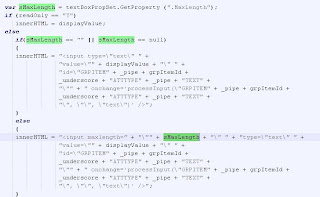When it comes to debugging Siebel application, no one beats the Siebel vanilla logs (events logs governed by environmental variables), but every developer use his own techniques to debug his configuration.
In this post I am discussing the way I debug my things.
I add following piece of code at every event that I want to monitor, and add my required parameters to it, and then just compile all the objects and run the scenario.
var date = new Date();
var fp = Clib.fopen("d:\\log.txt","a");
Clib.fputs("\n" + " BCPreInvokeMethod" + " " + date,fp);
Clib.fclose(fp);
In above code first line creates a date object that give the timestamp that will be written in the log file. Second line creates a file pointer that opens file/creates file in write mode. In next line Clib.fputs function writes string to the file.
We can now simply alter string according to our requirement, and get the exact output.
This way i get exact view of events and parameters in a flat file, that makes it really easy to understand the actual problem. If you are trying this code then you will get output something like :
PreInvokeMethod SetAspectSun Aug 02 2009 01:52:19
PreInvokeMethod SetAspectSun Aug 02 2009 01:52:19
PreInvokeMethod SetDefaultDurationSun Aug 02 2009 01:52:19
PreCanInvokeMethod DeleteRecordSun Aug 02 2009 01:52:19
PreCanInvokeMethod ShowQueryAssistantSun Aug 02 2009 01:52:19
PreCanInvokeMethod ToggleListRowCountSun Aug 02 2009 01:52:19
PreCanInvokeMethod ExecuteQuerySun Aug 02 2009 01:52:19
PreCanInvokeMethod GotoNextSetSun Aug 02 2009 01:52:19
PreCanInvokeMethod GotoPreviousSetSun Aug 02 2009 01:52:19
PreCanInvokeMethod NewQuerySun Aug 02 2009 01:52:19
PreCanInvokeMethod NewRecordSun Aug 02 2009 01:52:19
PreCanInvokeMethod PositionOnRowSun Aug 02 2009 01:52:19
PreCanInvokeMethod UndoQuerySun Aug 02 2009 01:52:19
PreCanInvokeMethod UndoRecordSun Aug 02 2009 01:52:19
PreCanInvokeMethod WriteRecordSun Aug 02 2009 01:52:19
PreCanInvokeMethod ShowPopupSun Aug 02 2009 01:52:19
PreCanInvokeMethod GetBookmarkURLSun Aug 02 2009 01:52:19
PreCanInvokeMethod FileSendMailSun Aug 02 2009 01:52:19
PreCanInvokeMethod FileSendFaxSun Aug 02 2009 01:52:19
PreCanInvokeMethod FileSendPageSun Aug 02 2009 01:52:19
It can be really helpful if you working on a new siebel application and doesn't know how things work.
Although it takes longer time to get the output, but it really helps when all other options fails.













